Your browser does not fully support modern features. Please upgrade for a smoother experience.

Submitted Successfully!
Thank you for your contribution! You can also upload a video entry or images related to this topic.
For video creation, please contact our Academic Video Service.
| Version | Summary | Created by | Modification | Content Size | Created at | Operation |
|---|---|---|---|---|---|---|
| 1 | Ashish Kumar Karmaker | -- | 3352 | 2023-04-20 17:17:54 | | | |
| 2 | Rita Xu | Meta information modification | 3352 | 2023-04-21 03:14:04 | | |
Video Upload Options
We provide professional Academic Video Service to translate complex research into visually appealing presentations. Would you like to try it?
Cite
If you have any further questions, please contact Encyclopedia Editorial Office.
Karmaker, A.K.; Islam, S.M.R.; Kamruzzaman, M.; Rashid, M.M.U.; Faruque, M.O.; Hossain, M.A. Smart City Transformation. Encyclopedia. Available online: https://encyclopedia.pub/entry/43302 (accessed on 11 January 2026).
Karmaker AK, Islam SMR, Kamruzzaman M, Rashid MMU, Faruque MO, Hossain MA. Smart City Transformation. Encyclopedia. Available at: https://encyclopedia.pub/entry/43302. Accessed January 11, 2026.
Karmaker, Ashish Kumar, S M Rezwanul Islam, Md Kamruzzaman, Md Mamun Ur Rashid, Md Omer Faruque, Md Alamgir Hossain. "Smart City Transformation" Encyclopedia, https://encyclopedia.pub/entry/43302 (accessed January 11, 2026).
Karmaker, A.K., Islam, S.M.R., Kamruzzaman, M., Rashid, M.M.U., Faruque, M.O., & Hossain, M.A. (2023, April 20). Smart City Transformation. In Encyclopedia. https://encyclopedia.pub/entry/43302
Karmaker, Ashish Kumar, et al. "Smart City Transformation." Encyclopedia. Web. 20 April, 2023.
Copy Citation
Cities worldwide are experiencing rapid urbanization and an increasing population, creating a pressing need for smart infrastructure to enhance citizen services. Dhaka, the capital of Bangladesh, faces similar technological and socio-economic challenges, making it crucial to transform it into a sustainable smart city.
smart city transformation
governance
transportation
IoT
smart grid
1. Introduction
Rapid urbanization and population growth are causing various socio-economic, technological, and environmental issues in the cities of developing countries, such as poor governance, traffic congestion, inadequate healthcare, education, and housing facilities, utility management problems, and environmental pollution. Dhaka, the capital of Bangladesh, has been ranked as the third least livable city in the world due to its lack of modern citizen services and basic facilities [1]. The city authorities aim to improve the infrastructure to offer better services to citizens, but this is associated with various stakeholder challenges. These challenges relate to real-time applications such as utility supply, healthcare, transportation, waste management, digitized education, and governance. Addressing these challenges through good governance and innovative technologies is crucial for Dhaka to become a smart city [2]. To develop a smart city, it is crucial to solicit input and feedback from citizens to address local issues and meet their needs [3]. Policies and frameworks should be designed to provide smart city services to citizens in a straightforward and accessible manner. Research on smart cities has shown that inadequate resources, accountability, and infrastructure contribute to poor service delivery in developing countries [4].
With the continual emergence of modern technologies, urban residents around the globe are increasingly interested in integrating smart technology into their city environments. However, implementing technological upgrades and overhauls is a complex and expensive process that requires adequate planning. Information and communication technologies, such as the Internet of Things (IoT), involve sensors, objects, and machines with unique identifiers and are widely used for real-time data transfer between network components. These technologies offer citizens real-time services while maintaining privacy and security with minimal human and machine intervention [5][6][7]. The significant growth of the global population poses challenges for governance, transportation, utility supplies, and socio-economic and environmental sustainability, particularly in highly populated areas. IoT-based smart cities present a promising solution, although internet access and speed throughout the city are crucial for establishing a smart city framework [8][9]. Incorporating geographic data from IoT devices can enhance governance structures, improve traffic and waste management, standardize healthcare facilities, optimize utility consumption, and reduce environmental pollution in a smart city framework, as suggested in [10].
The effectiveness of IoT infrastructure within a city can be hampered by inadequate and low-speed internet facilities [11]. Case studies on the digitization and smartening of cities in the European region are observed in the literature utilizing IoT devices [12][13]. Therefore, improving internet bandwidth and ensuring proper access are crucial for the success of the IoT framework. A project is underway in Bangladesh, in collaboration with the Dhaka North City Corporation (DNCC) and Local Government Engineering Division (LGED), to improve urban governance, develop GIS-based maps, and deliver smart services to citizens. Additionally, Japan and South Korea will fund several smart city projects in Bangladesh [14]. However, challenges such as transparency and accountability, insufficient infrastructure capacity, internet connectivity and speed, and limited access to online apps and web portals must be addressed [15][16].
2. Strategic Analysis for the existing Smart Cities
In this section, strategic analysis and SWOT analysis are performed for the existing intelligent cities in the world from other contemporary research, whereas the PESTEL analysis of the challenges of Dhaka, Bangladesh, for transforming into a smart city is presented.
These strategic analyses identify challenges and opportunities for smart city transformation. SWOT and PESTEL analyses are popular tools for project managers to make informed decisions. SWOT stands for Strengths, Weaknesses, Opportunities, and Threats, whereas PESTEL stands for Political, Economic, Social, Technical, Environmental, and Legal. SWOT analysis has two essential parts: internal (Strengths and Weaknesses) and external (Opportunities and Threats), demonstrating the existing challenges and opportunities for smart cities. Furthermore, PESTEL analysis shows the challenges encountered in conventional Dhaka, Bangladesh. Based on the literature observed on the aspects of Dhaka, the SWOT and PESTEL analyses are determined [17][18][19][20]. Figure 1a shows the SWOT analysis, whereas Figure 1b presents the PESTEL analysis for determining challenges and opportunities in smart city transformation.

Figure 1. (a): SWOT analysis for existing smart cities. (b): PESTEL analysis for Dhaka, Bangladesh.
2.1. Fuzzy-Based Smart City Prediction Technique
Based on the identified barriers in the SWOT and PESTEL analyses, essential parameters such as governance, transportation, healthcare facilities, utility management systems, waste management systems, and industrial automation were selected for the smart city transformation. A fuzzy rule-based smart city prediction framework was shown in Figure 2, where these parameters were considered input variables and the smart city was the output variable. The input variables are “governance”, “transportation”, “utility management”, “waste management”, “healthcare facility”, and “industrial automation.” The centroid-based defuzzification method was used in the fuzzy inference system. The input and output variables for the fuzzy inference system are presented in Figure 3.
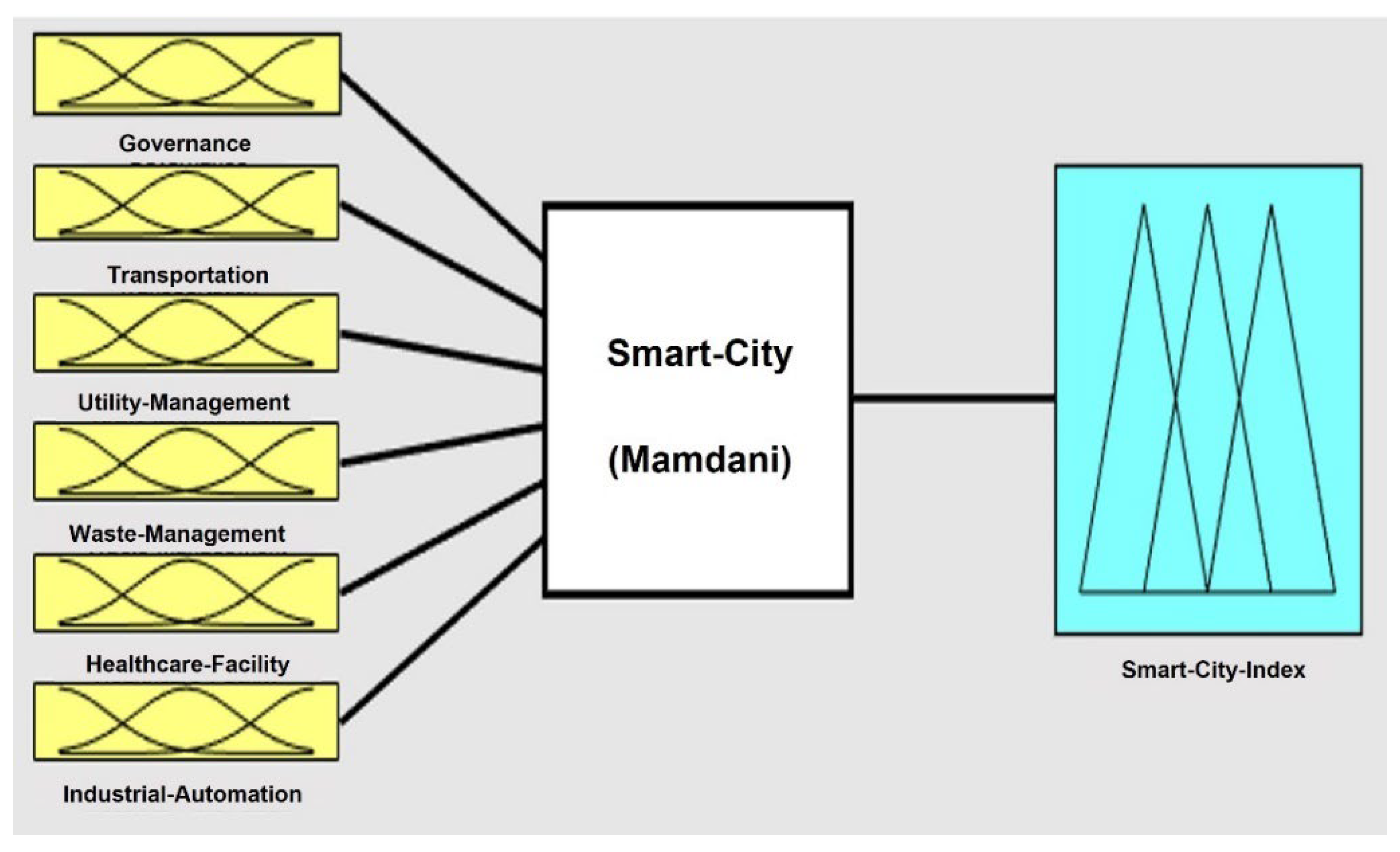
Figure 2. Fuzzy rule-based smart city prediction tool considering six input parameters.

Figure 3. Fuzzy input and output variables with membership functions.
Input and Output Variables
Three Gaussian membership functions are used in all input variables, and five triangular membership functions are used in the output variable. All the input and output variables vary from 0 to 1.
Thirty fuzzy “if-then” rules are included in this system, as shown in Figure 4, where the output variable varies depending on the combinations of input variables.
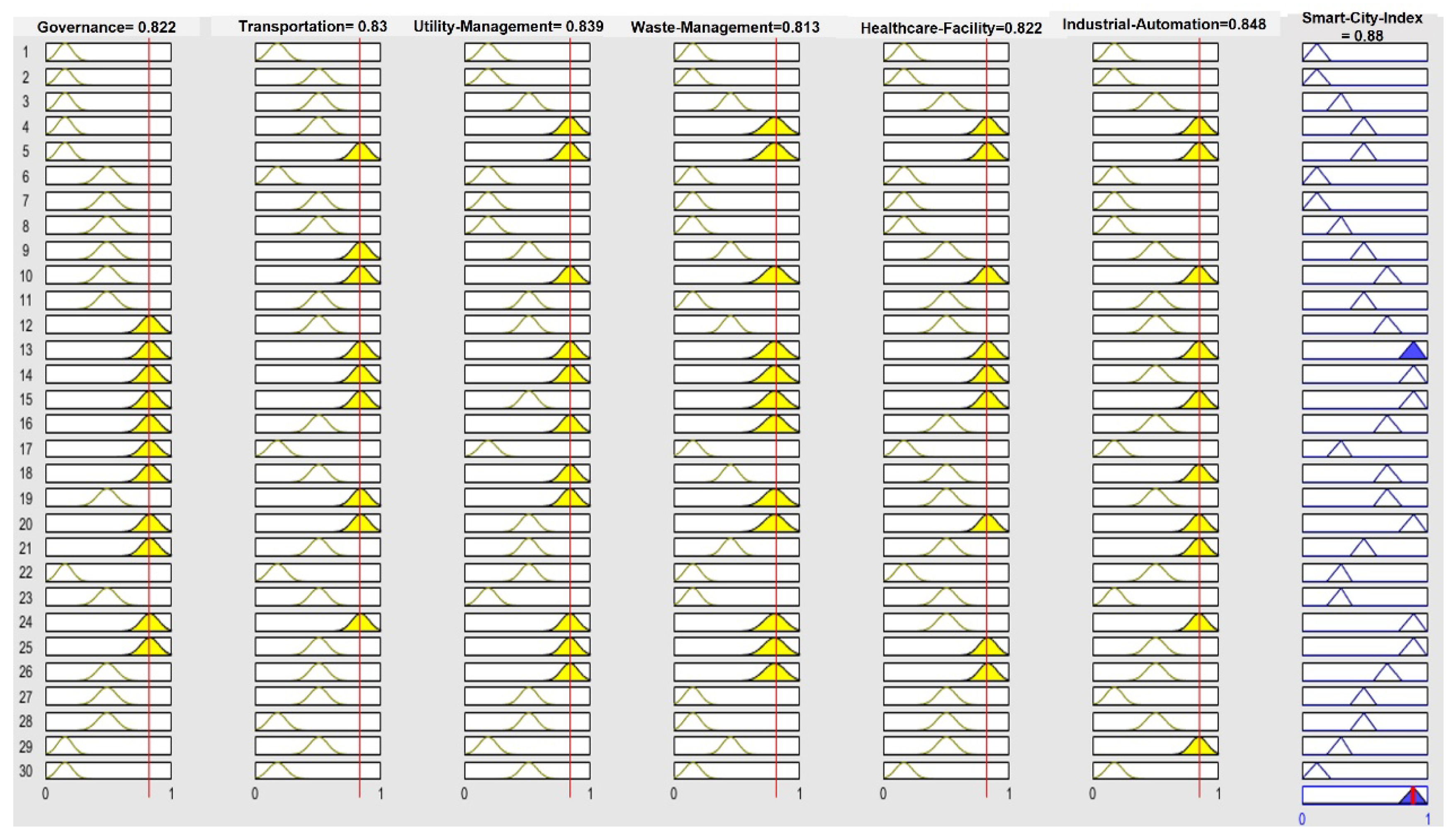
Figure 4. Fuzzy rule viewer.
Input variable “Governance” has categorized as three membership functions named “Weak”, “Neutral”, and “Good”, whereas “Transportation” has three membership functions named “Conventional_Bad”, “Modern_Average”, and “Modern_Good”. “Utility_management” has three categories of membership functions named “conventional”, “slightly_modern”, and “modern”, while “Waste_Management” has three membership functions named “Inadequate”, “Slightly_Adequate”, and “Adequate”. “Healthcare_Facility” refers to three membership functions named “Bad”, “Fair”, and “Enough”.
In a fuzzy logic system, input variables are described by membership functions that define how each input value is related to different degrees of membership in a set or category. In this case, each input variable has three membership functions describing different conditions or states the variable can take on. On the other hand, the output variable represents the degree of smart city development, and it is described by five membership functions that indicate how the input variables influence the output. The smart city index ranges from 0 to 1, where 0 represents a conventional city and 1 illustrates a fully developed smart city.
Figure 5 displays the surface views of the output variable in relation to the input variables. This means that the figure illustrates how the output value changes as the input variables change. The graph shows the combinations of input values and their corresponding output values.
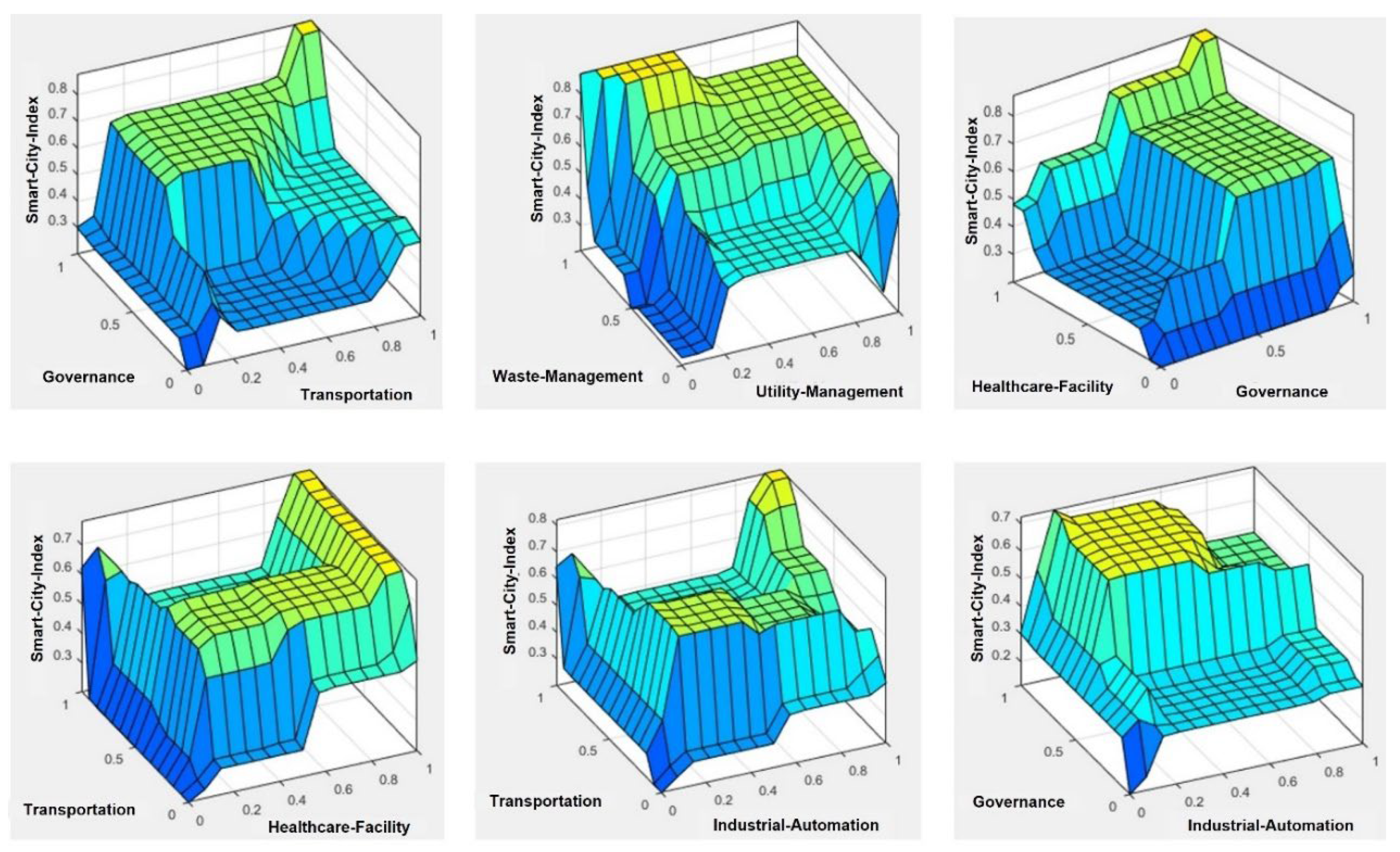
Figure 5. Surface view plot of smart city prediction scheme considering six key parameters.
Overall, this fuzzy logic system provides a way to model and analyze the development of smart cities using multiple input variables and a single output variable. By using membership functions to represent the relationships between inputs and outputs, the system can capture complex and uncertain relationships between variables and provide valuable insights into the development of smart cities.
2.2. Proposed Framework for Transforming Dhaka into a Smart City
This research proposes a framework for achieving sustainable transformation in Dhaka. This framework comprises five distinct phases that must be followed in order: identification and prioritization, planning, physical setup, development of IoT infrastructures, and monitoring and controlling. Each stage has a specific set of actions and goals that must be achieved to transform Dhaka into a smart city. These details are illustrated in Figure 6, which visually represents the framework and its various components.

Figure 6. Smart city transformation framework for Dhaka.
- (i)
-
Identification and Prioritization Phase
In this phase, the challenges and barriers to implementing IoT for smart city transformation are identified using recent relevant research. After that, the SWOT and PESTEL analyses are executed to identify the city system’s strengths, challenges, and opportunities.
- (ii)
-
Planning Phase
In the planning phase, policymakers must prioritize development efforts based on identified problems, redesign government policies for sustainable development, gather information from citizens, estimate the budget, and conceptualize solutions for identified barriers.
- (iii)
-
Physical Setup Phase
In the implementation phase, the policy developed in the planning phase is implemented to improve the city’s performance. Before incorporating intelligent technologies into the city’s network, basic facilities relevant to the transformation must be implemented. The processes required for this step include decentralization, the provision of adequate housing facilities, the development of roads and transportation systems, smart utility management, the implementation of environmental protection and control measures, waste management and recycling, and the formulation of strict legal policies. These steps are crucial to ensuring that the city’s infrastructure is in place before introducing smart technologies.
- (iv)
-
Development and Deployment of IoT Infrastructure Phase
In this phase, the requirements for developing IoT infrastructure are fulfilled. It incorporates sensors, hardware, software components, system analysis and design, data storage facilities, and data protection systems. These components are essential for enabling smart technologies to function effectively in the city. By implementing IoT infrastructure, the city can collect and analyze real-time data to optimize resource usage, enhance services, and improve the quality of life for its citizens.
- (v)
-
Continuous Monitoring and Controlling Phase
For sustainable and intelligent solutions to the problems associated with the city area, the IoT infrastructure should be kept under direct control and monitoring by the city authorities. Initially, the project can be more vulnerable due to the lack of proper expertise and knowledge to handle these devices. Moreover, the lack of consciousness and the ignoring of rules and policies may threaten the sustainable development of IoT in Dhaka. To ensure the quality and sustainability of the implemented project, regular maintenance of the project needs monitoring and control. Therefore, continuous monitoring and handling of the activities would be essential for transforming a city into a smart city.
3. Proposed Smart City Framework
The concept of a smart city revolves around leveraging advanced technologies and data analytics to improve the overall quality of life for its citizens. By deploying sensors, networks, and advanced analytics tools, cities can collect and process large amounts of data from various sources, including transportation systems, energy networks, public safety systems, and more.
3.1. Impact of the Framework
A smart city strengthens governance, improves transport and healthcare systems, saves energy, is concerned about environmental sustainability, incorporates updated policies, and maximizes societal adoption of modern technologies. In this section, the impacts are explained.
3.1.1. Impact on Governance
Developed countries have embraced smart governance and sustainable development by leveraging modern technologies to establish advanced infrastructure. Developing countries such as Bangladesh have also started adopting digital technologies, resulting in positive outcomes and benefits for citizens. Implementing web portals, online platforms, and mobile apps has directly empowered citizens, and the “access to information act” has helped ordinary citizens learn about their rights. In addition, the “access to information act (A2I)” in different government organizations in Bangladesh empowered ordinary citizens to know about their rights [21]. At present, citizens are confronting situations about a local government plan due to the embezzlement of the budget that leads to sluggish performance, and the consequence ends up with an extended duration [22][23]. The implementation of an intelligent city using modern technologies would result in significant changes in the governance system of the city. The modification primarily accentuates some outcomes, which are outlined as (a) the transparency of the governance system needs to improve, (b) the enhanced accountability of the in-charge personnel is required, (c) corruption will be reduced, and (d) lastly, the execution time will be alleviated.
3.1.2. Impact on Transport
The primary modes of transportation in Dhaka are motorcycles, rickshaws, public buses, Lagunas, private cars, CNG, minibusses, and taxis. The number of personal vehicles is increasing daily, which is predicted using linear extrapolation that in 2025 and 2030, there will be around 213,268 and 272,107 cars, respectively. This extrapolation shows that the demand for private vehicles increased, which is a primary challenge for the city authorities, although during 2020–2021, it slightly decreased due to the COVID-19 situation.
Figure 7 demonstrates statistics of registered private cars in Dhaka based on the report [24]. Daily public transport such as buses, autos, and CNG shares 1,691,729 trips (70.22%) and private vehicles such as taxis and motorcycles share 310,658 visits (12.89%) except for walking and cycling modes [25]. Due to the traffic congestion in Dhaka, 2.9 percent of gross domestic production (GDP) is reduced, whereas 6 to 10 percent of GDP is lost in the country’s other cities [26]. Research on the respondents in five groups estimated that traffic congestion costs USD 1010.76 per year per commuter, whereas the per-capita income is around USD 1211.70 [27]. It loses revenue, resulting in significant challenges to living standards and leading to the development of smart cities.
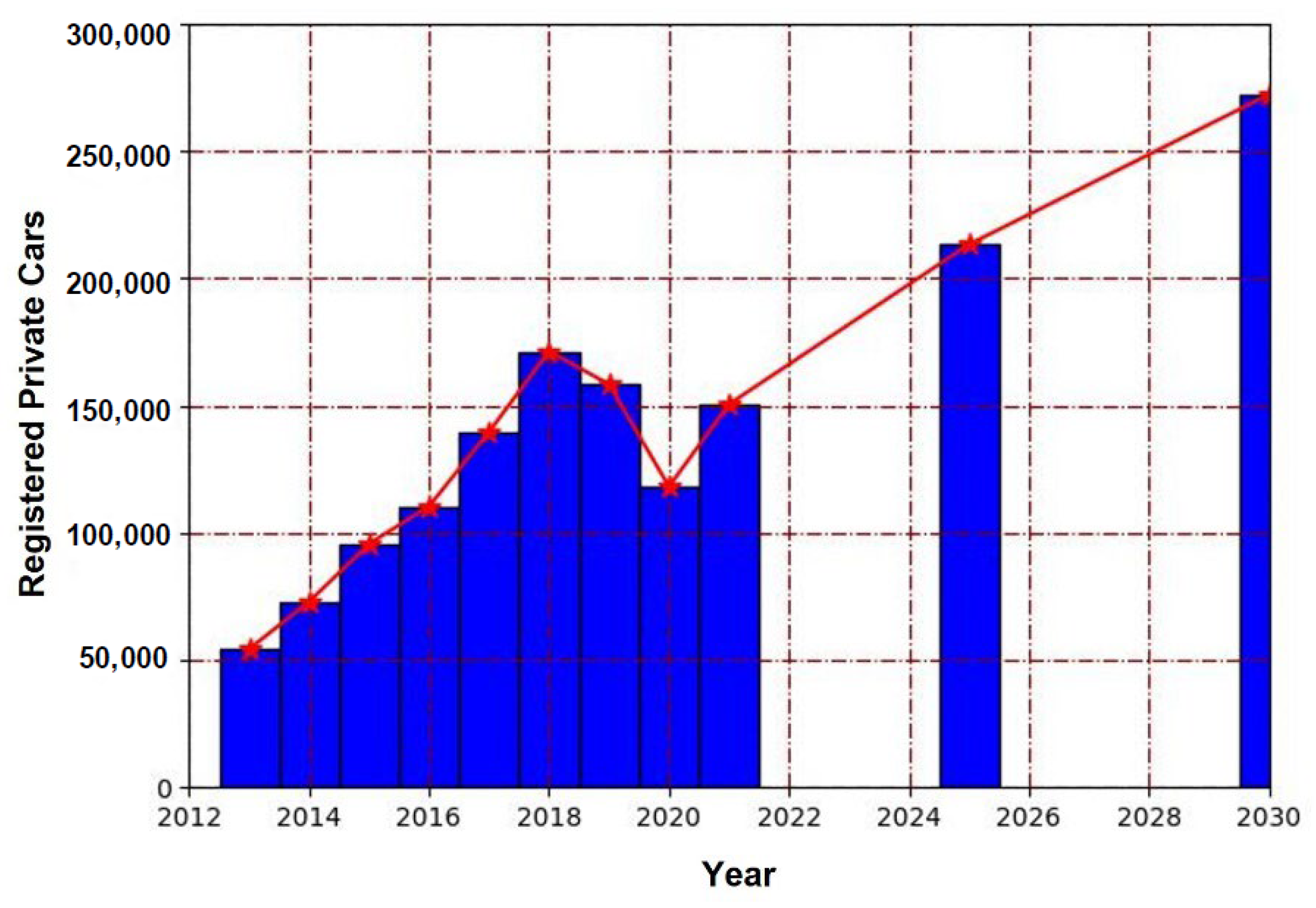
Figure 7. Statistics of registered private cars in Dhaka.
A news report discloses that the average traffic speed in Dhaka is 6.4 km per hour (kph), which will be 4.7 kph by 2035 with current vehicle growth. It also claims that the strategic transport plan could improve the average traffic speed by about 13.7 kph [28]. The times required to travel from Uttara, Dhaka, to different places in the city between 7 am and 10 am are indicated by green bars. The yellow bars represent the estimated time required to complete the journey at the smart city transportation speed of 13.7 kph. Figure 8 compares travel times for the distance between Uttara and different places in Dhaka.

Figure 8. Comparison of traveling time for the distance between Uttara to different places in Dhaka.
3.1.3. Impact on Utility Management System
The utility management system of Dhaka consists of three managing sectors: water, gas, and electricity. “Dhaka Water Supply and Sewerage Authority (DWASA)” published the demand and supply of water in terms of million liters per day in an annual report for 2018–19 [29]. The data interpreted in the graph is the prediction by the linear regression method based on the data published in the annual report. An article claims the system loss of DWASA is 38.78 percent and describes how the transparency of the billing system could bring the system loss down [30]. A study forecasted that in 2050, more than 12.37 million people may be deprived of quality water supply in Dhaka if proper solution steps are not taken [31]. Figure 9 depicts predicted water demand with and without system loss in the upcoming years.

Figure 9. Predicted demand for water per day with and without system loss.
Another report explained that Titas Gas Transmission and Distribution Company Limited faced a system loss of 3 to 12 percent in 2019 due to the absence of meters [32]. It also claimed the transparency of the billing process is an issue. Dhaka Electric Supply Company Limited is one of the distribution companies that the dwellers of Dhaka consume electricity from for their daily needs. The annual report published in 2020 says the system loss of this company is now 6.23 percent [33].
Figure 10 shows the expected electricity demand for the upcoming years in Dhaka. In Dhaka, two power distribution companies, Dhaka Power Distribution Company Ltd. and Dhaka Electric Supply Company Limited, are continuing projects for the automated and underground distribution systems. In addition, renewable solar panel installation guidelines for all residential and commercial buildings in Dhaka have a tremendous environmental impact on reducing GHG emissions.
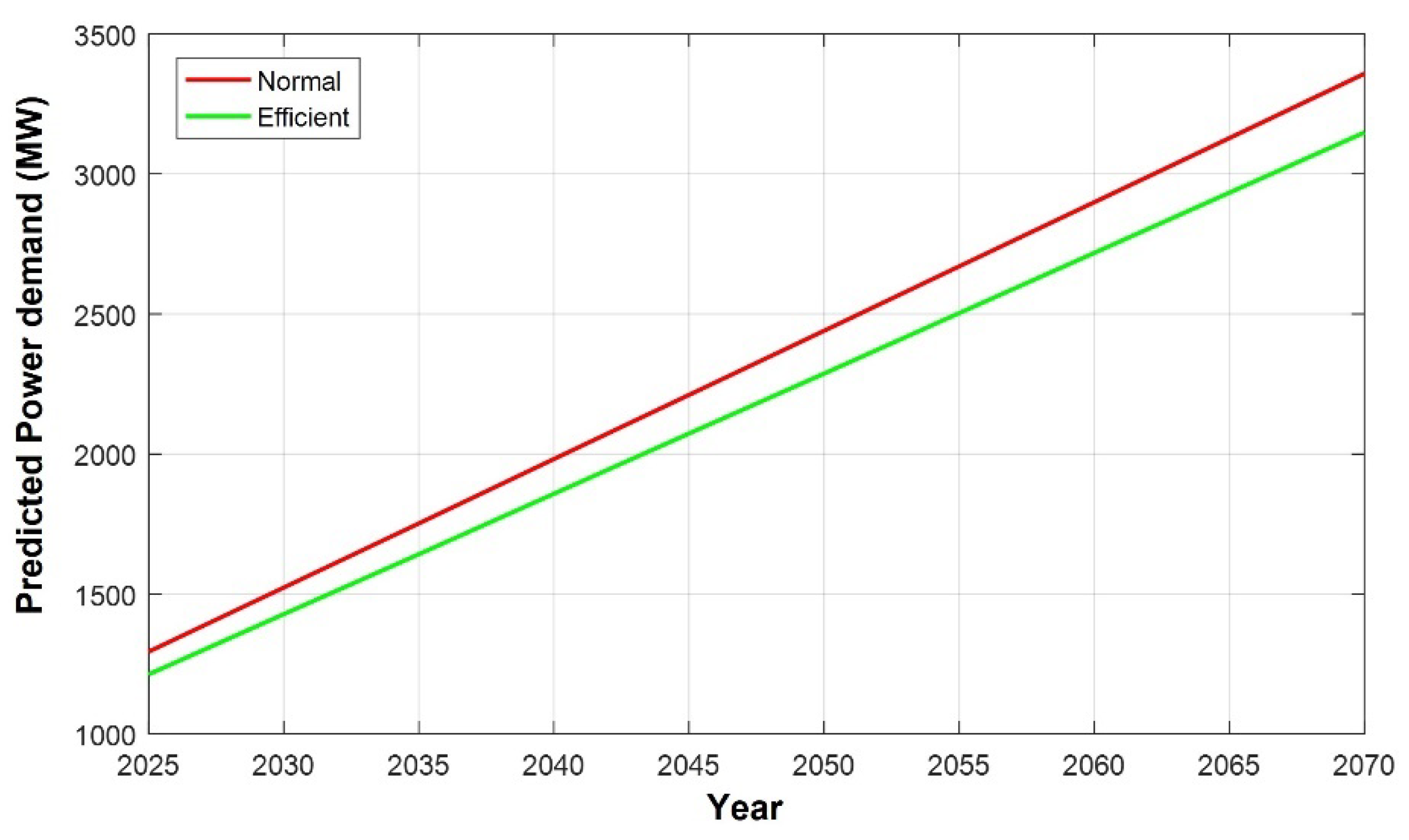
Figure 10. Predicted power demand of Dhaka with and without system loss.
3.2. Proposal for IoT-Based Smart City Management Technique
Transitioning from a conventional city to a smart city requires an efficient management plan to ensure the proper functioning of smart technologies and infrastructures. The management scheme must integrate infrastructure, data, and smart solution services to provide citizens with better facilities and services. The first step that city authorities must undertake is selecting sectors that require improvement. Subsequently, each industry must ensure effective data management practices, including data collection, processing, decision-making, and output services. Adequate government funding and technological infrastructure are essential for successfully implementing these tasks. However, during the data processing phase, the security and privacy of data must be a priority. To illustrate the proposed smart city management technique for the developed smart city, a graphical representation is presented in Figure 11.
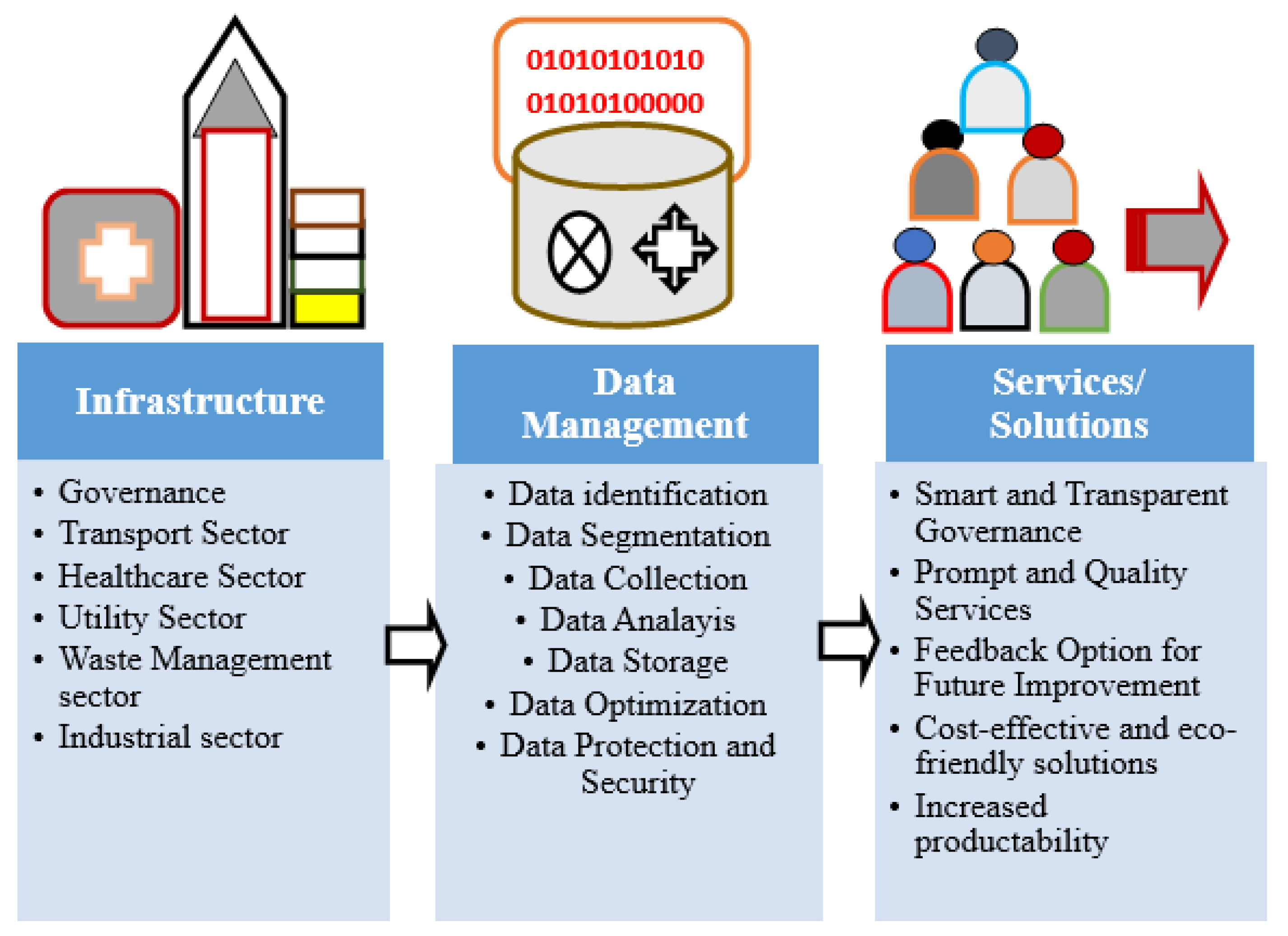
Figure 11. Proposed smart city management technique.
3.3. Policies for Sustainable Smart City Development in Dhaka
The low liveability index depicts Dhaka as more vulnerable due to the lack of facilities for fundamental rights, traffic conditions, pollution, criminal offenses, etc. Therefore, the government realized it needed to hire innovative solutions to achieve smart city facilities.
-
Decentralization of the administrative offices, industries, and education institutions: Dhaka, with a population density of 44,500 per square kilometer and a total population of 20.20 million, faces numerous challenges due to its rapid growth [34]. Over 80 percent of administrative offices, industries, and educational institutions are in Dhaka, making it even more vulnerable. The first step should be decentralization to reduce the population burden and transform it into a smart city. Decentralization has been shown to improve the overall efficiency of systems and promote sustainability, as indicated in several research papers [35]. Additionally, decentralization coupled with the use of ICT can make a city more livable by providing intelligent solutions for every need [36]. Therefore, Dhaka’s authority needs to explore alternatives to replace the institutions at the district level and monitor all branch activities using innovative technologies;
-
Transformation of the transport sector into a smart one: The rapid growth of population and private vehicles has resulted in traffic congestion and air pollution in Dhaka. Only 5% of the population uses personal cars, occupying 29% of the city’s space, reducing working hours, and causing traffic jams [37]. Inadequate traffic control, policy oversight, corruption, and a lack of road safety add to the problem. Integrating renewable resources such as solar and biomass can help reduce air pollution, and electric vehicles can be a promising solution for reducing carbon emissions [38]. Stand-alone solar and hybrid solar-biogas-based charging stations can be established in different parts of the city to enable proper charging [39][40]. IoT-based smart devices and artificial intelligence can also be utilized to reduce traffic congestion cost-effectively [41]. Online monitoring of traffic systems can help improve road safety and transform Dhaka into a sustainable and smart city;
-
IoT incorporation in industries: Integrating IoT devices into the manufacturing, textile, and tourism industries can significantly enhance efficiency and contribute to economic growth [42]. Bangladesh’s ready-made garment (RMG) industry has achieved global recognition, but monitoring activities, production, profits, human resources, and pollution is not regularly conducted. Proper control and management of waste disposal are also necessary to address environmental concerns [43]. However, many industries in Bangladesh continue to operate with conventional technologies, which decreases productivity and increases costs and time. Integrating innovative technologies may also lead to a temporary loss of production during implementation. Therefore, policymakers must conduct a feasibility study and strategic analysis before implementing these technologies to ensure a smooth transition and maximize benefits;
-
IoT in waste management: In Dhaka, every day, 4200 tons of waste, i.e., municipal solid waste and healthcare industry waste, are generated, which leads to environmental pollution [44]. The waste-to-energy (WTE) project can be a good option for recovering energy and recycling it into new products. Research in South Africa said that the WTE project manages solid wastes and reduces environmental pollution [45]. IoT-based waste management promotes real-time monitoring of garbage levels, selecting waste transport routes, and segmenting waste, improving the quality of city life. Therefore, utilizing IoT-based smart waste management techniques can be an excellent way to make a liveable city;
-
IoT in environmental protection and monitoring: The rapid proliferation of population, urbanization, and the transportation sector are responsible for overall pollution in a city. The increasing pollution is raising the chance of health risks for the citizens. However, it must monitor the environment strictly to reduce health risks due to a polluted environment. Closely monitoring waste disposal and enforcing strict laws may help in controlling pollution. Therefore, collecting and analyzing data based on artificial intelligence will be a new research field and promote environmental sustainability [46];
-
Strengthening governance system: A robust governance system is a powerful tool for making a city smart. However, in Dhaka, corruption, illegal use of the law, increased criminal offense, unethical work, and substantial human interaction weaken the governance system [47]. Robust internet connectivity with available sensor networks can improve performance within a smart city. Therefore, infrastructure and trained professionals are necessary to maintain innovative integrated systems using investment from the government or city authorities.
References
- Nunes, S.A.; Ferreira, F.A.; Govindan, K.; Pereira, L.F. Cities go smart! A system dynamics-based approach to smart city conceptualization. J. Clean. Prod. 2021, 313, 127683.
- Lu, H.-P.; Chen, C.-S.; Yu, H. Technology roadmap for building a smart city: An exploring study on methodology. Futur. Gener. Comput. Syst. 2019, 97, 727–742.
- Lee, J.; Lee, H. Developing and validating a citizen-centric typology for smart city services. Gov. Inf. Q. 2014, 31, S93–S105.
- Bertot, J.; Estevez, E.; Janowski, T. Universal and contextualized public services: Digital public service innovation framework. Gov. Inf. Q. 2016, 33, 211–222.
- Zhou, W.; Jia, Y.; Peng, A.; Zhang, Y.; Liu, P. The effect of iot new features on security and privacy: New threats, existing solutions, and challenges yet to be solved. IEEE Internet Things J. 2018, 6, 1606–1616.
- Wan, J.; Chen, M.; Xia, F.; Li, D.; Zhou, K. From Machine-to-Machine Communications towards Cyber-Physical Systems. Comput. Sci. Inf. Syst. 2013, 10, 1105–1128.
- Gubbi, J.; Buyya, R.; Marusic, S.; Palaniswami, M. Internet of Things (IoT): A vision, architectural elements, and future directions. Future Gener. Comput. Syst. 2013, 29, 1645–1660.
- Al Ridhawi, I.; Otoum, S.; Aloqaily, M.; Jararweh, Y.; Baker, T. Providing secure and reliable communication for next generation networks in smart cities. Sustain. Cities Soc. 2020, 56, 102080.
- Li, S.; Da Xu, L.; Zhao, S. 5G Internet of Things: A survey. J. Ind. Inf. Integr. 2018, 10, 1–9.
- Arasteh, H.; Hosseinnezhad, V.; Loia, V.; Tommasetti, A.; Troisi, O.; Shafie-khah, M.; Siano, P. Iot-based smart cities: A survey. In Proceedings of the 2016 IEEE 16th International Conference on Environment and Electrical Engineering (EEEIC), Florence, Italy, 7–10 June 2016.
- Baowaly, M.K.; Bhuiyan, M. Accessibility analysis and evaluation of Bangladesh government websites. In Proceedings of the 2012 International Conference on Informatics, Electronics & Vision (ICIEV), Dhaka, Bangladesh, 18–19 May 2012; pp. 46–51.
- Velsberg, O.; Katrin, J.; Ulrika, H.W.; Ted, S. IoT Triggers. How municipalities are transforming to smarter cities through IoT use. Scand. J. Inf. Syst. 2021, 33, 2.
- Nesse, P.J.; Erdal, O.B. Smart Digitalization in Nordic Cities and Municipalities Through Internet of Things. In Economics and Finance Readings: Selected Papers from Asia-Pacific Conference on Economics & Finance, 2021; Springer Nature: Singapore, 2022; pp. 33–55.
- Dhaka Smart City Development Project. Available online: https://dncc.portal.gov.bd/sites/default/files/files/dncc.portal.gov.bd/publications/a9583567_6036_404d_8bdc_4a79c58162f3/Tor%20(Local).pdf (accessed on 18 March 2023).
- Hasan, S.; Hoque, M.R.; Chowdhury, S.R.; Mohib, A.A.; Ahad, M.A. Challenges of IT Adoption at Educational Institutions: Lessons from Bangladesh. Int. J. Inf. Syst. Soc. Change (IJISSC) 2020, 11, 66–90.
- Ahmed, N.; Ahmed, A.; Mamun, M. An Insight into an Eco-friendly Smart City: A Step towards Achieving Urban Sustainability in Dhaka; United International University: Dhaka, Bangladesh, 2020.
- Akash, M.; Akter, J.; Tamanna, T.; Kabir, M.R. The Urbanization and Environmental Challenges in Dhaka City. In Proceedings of the 7th International RAIS Conference on Social Sciences, Tampa, FL, USA, 19–20 February 2018.
- Murad, M.W.; Alam, M.M.; Shahriar, S.M. Splitting up Dhaka city: Rationales, challenges and prospects as a sustainable city. Int. J. Innov. Sustain. Dev. 2021, 15, 322–335.
- Aghlara, E.; Sahin, U. Environmental Challenges Associated with Land Use Plan in Dhaka City. Int. J. Adv. Technol. Sci. Res. 2021, 2, 261–285.
- Khan, S.I.; Khan, A.; Sarker MN, I.; Huda, N.; Zaman, M.R.; Nurullah, A.; Rahman, M.Z. Traffic congestion in Dhaka city: Suffering for city dwellers and challenges for sustainable development. Eur. J. Soc. Sci. 2018, 57, 116–127.
- Anwar, M.; Frings-Hessami, V. Empowering women through access to information: The Sustainability of a community informatics project in Bangladesh. In International Conference on Information; Springer: Cham, Switzerland, 2020; pp. 3–14.
- Jahan, M. Governance Characteristics of Dhaka City for Ensuring Implementation of Land Use Planning. In AUC 2019; Springer: Singapore, 2021; pp. 109–121.
- Swapan, M.S.H.; Khan, S. Urban informality and parallel governance systems: Shaping citizens’ engagements in urban planning processes in Bangladesh. Int. Plan. Stud. 2022, 27, 1–17.
- Motor Vehicle Registered in Dhaka City, Bangladesh. Available online: https://www.ceicdata.com/en/bangladesh/motor-vehicle-registered/motor-vehicle-registered-dhaka-total (accessed on 18 March 2023).
- Sustainable Urban Transport Index, Dhaka. Available online: https://www.unescap.org/sites/default/files/SUTI%20Mobility%20Assessment%20Report%20-%20Dhaka.pdf (accessed on 18 March 2023).
- Dhaka Traffic Congestion Eats up 2.9% of GDP: Study. Available online: https://www.tbsnews.net/economy/direct-effect-congestion-eating-25-gdp-337711 (accessed on 18 March 2023).
- Haider, M.Z.; Papri, R.S. Cost of traffic congestion in Dhaka Metropolitan City. Public Transp. 2021, 13, 287–299.
- Bangladesh Priorities: Urban Transport, Gallagher. Available online: https://www.copenhagenconsensus.com/publication/bangladesh-priorities-urban-transport-gallagher#:~:text=Today%2C%20the%20average%20traffic%20speed,about%20as%20slow%20as%20walking (accessed on 18 March 2023).
- Dhaka Water Supply Authority. Available online: http://dwasa.org.bd/site/page/a87b7dc4-6139-4da2-b1ef-bf5960b234d6 (accessed on 18 March 2023).
- System Loss of Dhaka WASA to 38.78 Percent. Available online: https://www.thedailystar.net/news-detail-143696 (accessed on 18 March 2023).
- Baten, M.A.; Lisa, K.S.; Chowdhury, A.S. Water Supply of Dhaka City: Present Context and Future Scenarios. In Water Security in Asia; Springer: Cham, Switzerland, 2021; pp. 351–367.
- No Metering Keeps Titas in the Dark over Gas Receipts. Available online: https://tbsnews.net/bangladesh/energy/no-metering-keeps-titas-dark-over-gas-receipts-150202 (accessed on 18 March 2023).
- Annual Reports, DESCO. Available online: http://ocsms.desco.org.bd:8080/publicinfo/annualreport (accessed on 18 March 2023).
- Jamal, A.H.M.S.I.M.; Ahsan, A.; Ahmed, S.; Akter, S.; Sultana, R.; Nahar, A.; Uddin, R. Physicochemical and Microbiological Quality of Potable Water Supplied by DWASA in Dhaka City of Bangladesh. Am. J. Biol. Environ. Stat. 2020, 6, 1–6.
- Leal-Arcas, R. Decentralization and Empowering the Citizen. In Solutions for Sustainability; Springer: Cham, Switzerland, 2019; pp. 201–247.
- Rachmawati, R. ICT-Based Innovation in the Smart City Masterplan and Its Relation to Regional Planning. In IOP Conference Series: Earth and Environmental Science; IOP Publishing: Bristol, UK, 2019; Volume 328, p. 012026.
- Promy, N.; Islam, S. A Smart Android Based Parking System to Reduce the Traffic Congestion of Dhaka City. In Proceedings of the 2019 21st International Conference on Advanced Communication Technology (ICACT), Pyeongchang, Republic of Korea, 17–20 February 2019; pp. 124–128.
- Hoang, A.T.; Pham, V.V.; Nguyen, X.P. Integrating renewable sources into energy system for smart city as a sagacious strategy towards clean and sustainable process. J. Clean. Prod. 2021, 305, 127161.
- Ahmed, R.; Karmaker, A.K. Challenges for Electric Vehicle Adoption in Bangladesh. In Proceedings of the 2019 International Conference on Electrical, Computer and Communication Engineering (ECCE), Cox’s Bazar, Bangladesh, 7–9 February 2019; pp. 1–6.
- Karmaker, A.K.; Ahmed, M.R.; Hossain, M.A.; Sikder, M.M. Feasibility assessment & design of hybrid renewable energy based electric vehicle charging station in Bangladesh. Sustain. Cities Soc. 2018, 39, 189–202.
- Soomro, S.; Miraz, M.H.; Prasanth, A.; Abdullah, M. Artificial intelligence enabled IoT: Traffic congestion reduction in smart cities. In Proceedings of the Smart Cities Symposium, Sakhir, Bahrain, 22–23 April 2018; IET Conference Publications: London, UK, 2018; pp. 81–86.
- Zarei, M.; Mohammadian, A.; Ghasemi, R. Internet of things in industries: A survey for sustainable development. Int. J. Innov. Sustain. Dev. 2016, 10, 419–442.
- Delowar Hossain, S.; Ferdous, S.R. RMG’s hot spot surrounded by challenges: A review landscape of Bangladesh readymade garments (RMG). J. Sci. Res. Dev. 2015, 8, 29–38.
- Khan, I.; Kabir, Z. Waste-to-energy generation technologies and the developing economies: A multi-criteria analysis for sustainability assessment. Renew. Energy 2020, 150, 320–333.
- Dlamini, S.; Simatele, M.D.; Kubanza, N.S. Municipal solid waste management in South Africa: From waste to energy recovery through waste-to-energy technologies in Johannesburg. Local Environ. 2019, 24, 249–257.
- Wu, Y.C.; Wu, Y.J.; Wu, S.M. An outlook of a future smart city in Taiwan from post–Internet of things to artificial intelligence Internet of things. In Smart Cities: Issues and Challenges; Elsevier: Amsterdam, The Netherlands, 2019; pp. 263–282.
- Khan, A.; Jhanjhi, N.Z.; Humayun, M.; Ahmad, M. The Role of IoT in Digital Governance. In Employing Recent Technologies for Improved Digital Governance; IGI Global: Hershey, PA, USA, 2020; pp. 128–150.
More
Information
Subjects:
Others
Contributors
MDPI registered users' name will be linked to their SciProfiles pages. To register with us, please refer to https://encyclopedia.pub/register
:
View Times:
916
Revisions:
2 times
(View History)
Update Date:
21 Apr 2023
Notice
You are not a member of the advisory board for this topic. If you want to update advisory board member profile, please contact office@encyclopedia.pub.
OK
Confirm
Only members of the Encyclopedia advisory board for this topic are allowed to note entries. Would you like to become an advisory board member of the Encyclopedia?
Yes
No
${ textCharacter }/${ maxCharacter }
Submit
Cancel
Back
Comments
${ item }
|
More
No more~
There is no comment~
${ textCharacter }/${ maxCharacter }
Submit
Cancel
${ selectedItem.replyTextCharacter }/${ selectedItem.replyMaxCharacter }
Submit
Cancel
Confirm
Are you sure to Delete?
Yes
No




